
|
|

May 1, 2009
Bakersfield, California (part I)

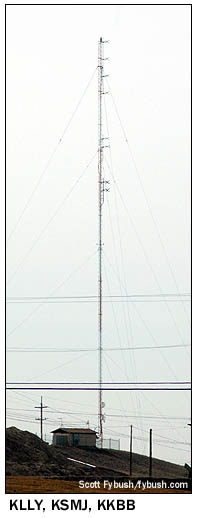 Ah,
California!
Ah,
California!
For a tower-hunter based in upstate New York, the Golden State has always held a special appeal, especially during those long, gray winter months (and even on this rather gray, damp first day of May.)
Over the course of a couple of decades, we've taken the opportunity to visit stations all over California, including pretty much everything up and down the coast from Sonoma to San Diego. But even with all those trips (and a year of living near the Nevada border in rural Inyo County), our survey of California's tower sites was still missing some big swaths of the state.
In addition to northern California - and, yes, Chico, Redding and Eureka, we still intend to get up your way someday - we found ourselves missing most of the Central Valley, the broad, flat expanse of farmland that stretches south from Sacramento through Stockton and Modesto and Merced and Fresno and Visalia to Bakersfield.
That's a lot of territory to cover all at once, but our trip out to the 2008 NAB Show in Las Vegas gave us a chance to chip away at a significant piece of it by heading south and west from Vegas on I-15 and California 58 and spending a day in the Bakersfield market.
Bakersfield stretches out along two transportation corridors: California 99 is the "Main Street" of the Central Valley, going north to Tulare and Fresno and south toward Los Angeles, two hours away. California 58 goes east as a freeway toward Tehachapi and Barstow (connecting with I-15 to Vegas) and west as a twisty mountain road over the coastal hills toward San Luis Obispo. Downtown Bakersfield sits just northeast of the junction of those two major highways, and most of the city's AM stations come from sites lined up just south of 58.
We, however, started at the northeastern corner of the market, up where downtown gives way to rolling hills dotted by oil wells, one of the region's big industries. Indeed, the first two sites we feature this week are surrounded by oil fields, in the appropriately-named suburb of Oildale. KKXX (93.1 Shafter), a class A adult-hits station ("Pirate Radio") stands by itself on Granite Road, about half a mile north of another tower shared by three Buckley Broadcasting FMs: B1s KLLY (95.3 Oildale, hot AC "Kelly 95") and KKBB (99.3 Bakersfield, rhythmic oldies "Groove 99.3") and class A KSMJ (97.7 Shafter, AC "97.7 the Breeze.")
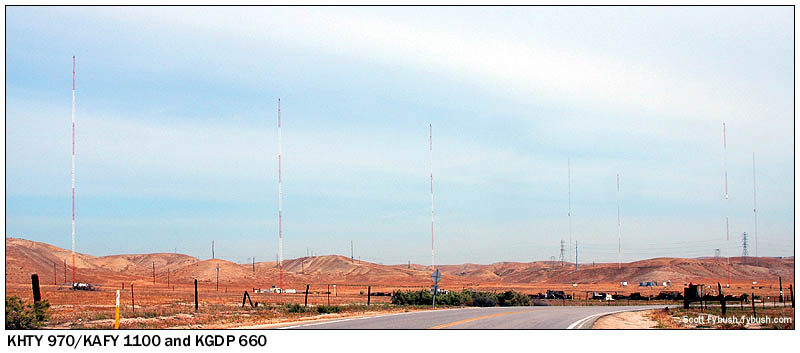
About three miles to the east, the China Grade Loop road that passes through Oildale's oil fields turns north and approaches a big cluster of AM towers. The three on the left were here first, carrying the AM 970 facility that came on in the early sixties as KBIS. In 1977, country giant KUZZ moved from its original daytime home on 800 up to 970 - and in 1984, KUZZ owner Buck Owens upgraded facilities once again, swapping 970 for the much bigger 550 signal that had been home to legendary top-40 station KAFY. But the KAFY calls didn't find as much success up the dial at 970, and the 970 signal (an unusual one with more power at night - 5 kW - than by day, when it runs just 1000 watts) went through a succession of calls and formats. When we visited in 2008, it was Clear Channel-owned KHTY, running the "W Radio" service from Mexico; since then, it's flipped again to Fox Sports Radio.
The KAFY calls, meanwhile, came back to this site: they're on a Spanish religious signal at 1100 that signed on from here in 1999 as a diplex.
And not long before our 2008 visit, KGDP (660) had migrated inland from its original home in Orcutt (near Santa Maria on the coast) to Oildale, building a four-tower array next to the 970/1100 site to run 8 kW by day, 6 kW by night. The station was testing when we stopped by, and hasn't been on the air much -if at all - since then.
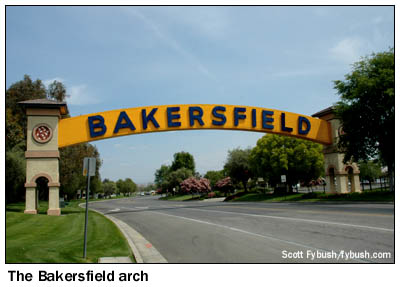
|
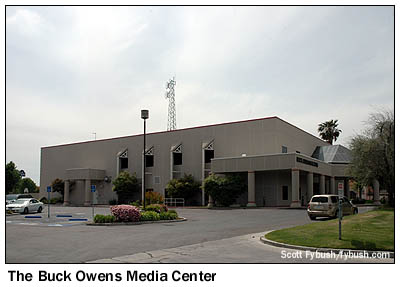
|
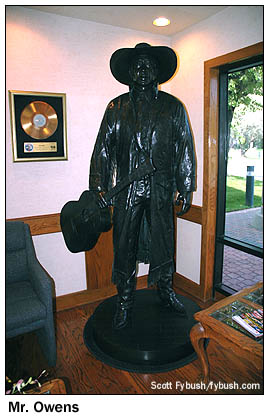 We didn't
get to see many studios while we were in town, in part because
it was just before NAB week and a lot of people were getting
ready to head off to Vegas. So there were no tours to be had
at Buckley's studios in Oildale, just off Highway 99 near the
airport. But a few exits to the south on 99, heading back toward
downtown, our old rec.radio.broadcasting friend Mark Howell
was happy to show us around KUZZ, where he's been news director
since 1977 (minus a few years spent out of the market, mostly
up north at San Francisco's KCBS, in the eighties.)
We didn't
get to see many studios while we were in town, in part because
it was just before NAB week and a lot of people were getting
ready to head off to Vegas. So there were no tours to be had
at Buckley's studios in Oildale, just off Highway 99 near the
airport. But a few exits to the south on 99, heading back toward
downtown, our old rec.radio.broadcasting friend Mark Howell
was happy to show us around KUZZ, where he's been news director
since 1977 (minus a few years spent out of the market, mostly
up north at San Francisco's KCBS, in the eighties.)
KUZZ today is housed in the Buck Owens Media Center at 3221 Sillect Drive, in an office park just off the highway, and while the legend of country music left us in 2006, his legacy lives on here in many forms.
The building housing the stations sits just past the reconstructed "Bakersfield Arch," next to the Crystal Palace, the entertainment venue Owens built in the mid-nineties as a showplace for the "Bakersfield Sound" he'd shaped for so many decades. (It was the last place he ever performed; he died in his sleep the night after his weekly concert there.)
KUZZ itself shares the Media Center with the Buck Owens Productions offices, and entering the KUZZ half of the building brings us right into a shrine to Owens, complete with gold records on the walls and a big bronze statue of the man himself in the corner.
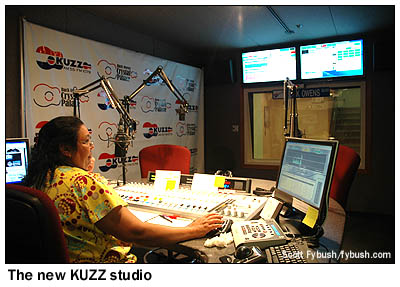 After
its many moves around the AM dial - from 800 to 970 to 550 -
KUZZ today finds its listeners on the FM dial. In 1988, Owens
began simulcasting KUZZ on 550 and a big class B FM facility
at 107.9, which had previously been rocker KKXX and before that
was country KZIN and progressive rock KBBY-FM.
After
its many moves around the AM dial - from 800 to 970 to 550 -
KUZZ today finds its listeners on the FM dial. In 1988, Owens
began simulcasting KUZZ on 550 and a big class B FM facility
at 107.9, which had previously been rocker KKXX and before that
was country KZIN and progressive rock KBBY-FM.
Along the way, Owens added a second FM on 107.1, running automated classic country as KCWR. For a time, AM 550 was simulcasting KCWR, but today it's returned to the KUZZ side of the house, simulcasting with FM 107.9 to provide broad Central Valley coverage for KUZZ's top-rated country format.
When we visited, KUZZ had just finished building a new studio facing the main hallway at the front of the building, where we found midday jock Casey McBride on the air. Check out the neat setup for the Enco automation monitors: instead of the usual small monitors mounted right above the console, the Enco screens appear on two big plasma displays mounted above the studio window. (Only the guys who visit get impressed by that, McBride jokes...)
A row of studios around the corner provides space for production, news (Mark heads a three-person news department that routinely outguns the market's news-talk AM stations) and for KCWR; the old KUZZ studio down that hall is being renovated as a new production room as well.
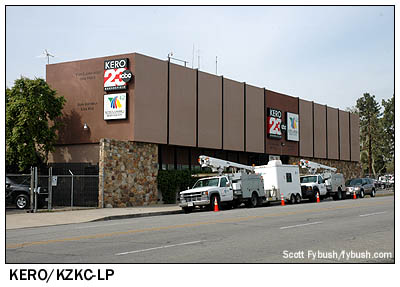
|
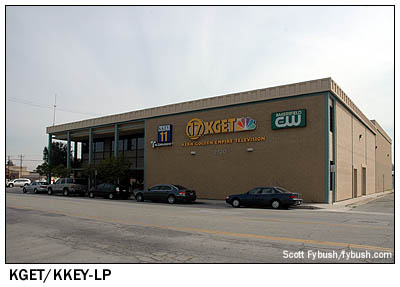
|
 After
a nice lunch with Mark, we head out to see downtown Bakersfield,
where all three of the market's big TV stations are located within
a mile or so of each other.
After
a nice lunch with Mark, we head out to see downtown Bakersfield,
where all three of the market's big TV stations are located within
a mile or so of each other.
From east to west, we start at 321 21st Street, home to McGraw-Hill's KERO-TV, the oldest TV station in the market. KERO started out on channel 10, but the FCC's controversial "deintermixture" policy forced it to move to channel 23 in 1963, turning Bakersfield into an all-UHF market. (Ironically, KERO-DT operates on...channel 10!)
After spending time with NBC and then CBS, KERO flipped to ABC in 1996. McGraw-Hill added an Azteca America LPTV, KZKC-LP 42, a few years back.
There are LPTV subchannels at the other TV stations here, too: at 2120 L Street, in the heart of downtown, NBC affiliate KGET (Channel 17) also operates Telemundo outlet KKEY-LP (Channel 11) and a CW subchannel on 17.2. (There's even Spanish-language local evening news on KKEY, though we didn't get to town in time to see it.)
On the west end of downtown, in an office park adjacent to Highway 99, Fisher-owned ABC affiliate KBAK-TV (Channel 29) occupies a low-slung building shared with Fox affiliate KBFX-CA (Channel 58).
We didn't get to the TV transmitter sites, located up in the Sierra foothills northeast of Bakersfield, but we did get to plenty of AM sites - and we'll show those to you in next week's installment. (In the meantime, visit our sister site TopHour.com next Wednesday to hear the first of two installments of Bakersfield legal IDs...)
- Previous Site of the Week: Mount Arden, Las Vegas
- Next Week: Bakersfield, CA (Part II)
- Site of the Week INDEX!
- How can you help support Site of the Week? Click here!
- Submit your suggestions for a future Site of the Week!
